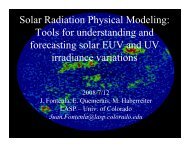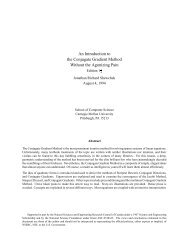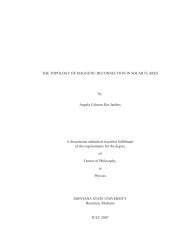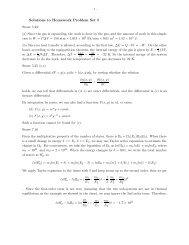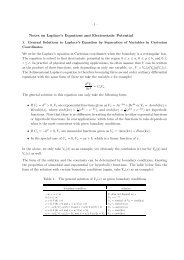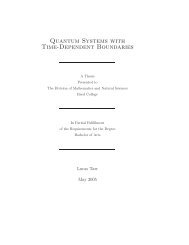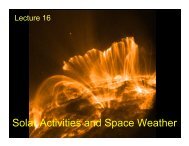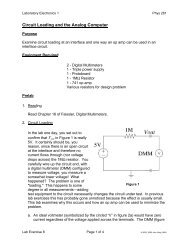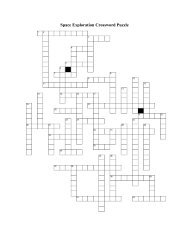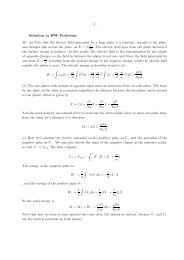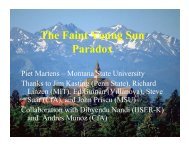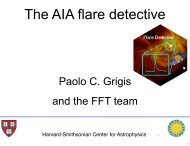Magara, T., Shibata, K., & Yokoyama, T. 1997, ApJ, 487, 437
Magara, T., Shibata, K., & Yokoyama, T. 1997, ApJ, 487, 437
Magara, T., Shibata, K., & Yokoyama, T. 1997, ApJ, 487, 437
Create successful ePaper yourself
Turn your PDF publications into a flip-book with our unique Google optimized e-Paper software.
446 MAGARA, SHIBATA, & YOKOYAMA<br />
resistivity (at t \ t ). Then the outÑow from the neutral<br />
point is rapidly developing, 2<br />
beginning to accelerate the<br />
magnetic island (from t to t ). When the anomalous resis-<br />
tivity sets in, the neutral-point 2 3<br />
electric Ðeld arises, but it<br />
does not reach its maximum value as long as a large<br />
amount of perpendicular magnetic Ðeld exists around the<br />
neutral point because of the inhibition of the efficient magnetic<br />
reconnection. At t \ t , the neutral-point electric Ðeld<br />
reaches its maximum, which 3<br />
implies that the high-energy<br />
electrons can be generated and high-energy radiation, such<br />
as hard X-rays, can be emitted. At that time there occurs the<br />
violent energy release causing a reconnection jet which<br />
forms the fast MHD shock at the bottom of the magnetic<br />
island. After that the O-point (central part of the magnetic<br />
island) turns to be behind the shock, and hence strong acceleration<br />
no longer occurs.<br />
Since the role of the perpendicular magnetic Ðeld in the<br />
scenario described above is very important, we will attempt<br />
a more detailed study of this property in the future. This<br />
kind of study was done by Birn & Hesse (1991), who discussed<br />
magnetic reconnections in the EarthÏs magnetotail<br />
and found the concentration of the electric Ðeld around an<br />
X-point.<br />
6. SUMMARY<br />
Finally, we summarize the main results of our paper as<br />
follows:<br />
1. We investigate the plasmoid dynamics in the evolution<br />
of eruptive Ñares. At the Ðrst stage, the magnetic island<br />
slowly rises by the upÑow produced by the initial resistive<br />
perturbation and then begins to be accelerated when the<br />
anomalous resistivity sets in. This acceleration stops after<br />
the fast MHD shock is formed at the bottom of the magnetic<br />
island, which implies that the upÑow around the<br />
central part of the magnetic island is no longer strong.<br />
However, it is still an open question whether the magnetic<br />
island continues to rise at a constant velocity later.<br />
2. A time lag between the start time of the magnetic<br />
island acceleration and the peak time of the neutral-point<br />
electric Ðeld is explained by the inhibition of the magnetic<br />
reconnection by the perpendicular magnetic Ðeld, although<br />
the detailed process should be studied in the future. This<br />
time lag is similar to the observed time lag between the start<br />
time of the plasmoid acceleration and the peak time of the<br />
hard X-ray intensity (Ohyama & <strong>Shibata</strong> <strong>1997</strong>).<br />
3. Comparing the simulation results with the observational<br />
ones, we Ðnd that the real rising motion of the<br />
plasmoid is quite slower than our simulation. By studying<br />
the initially perturbed region, we conjecture that in actual<br />
situations, the initial resistive perturbation proceeds very<br />
weakly and at many positions inside the arcade.<br />
4. Those models in which the vertical extent of a magnetic<br />
arcade is several times larger than its horizontal extent<br />
are unstable for resistive perturbations and are expected to<br />
cause the anomalous resistivity, leading to the eruptive<br />
phenomena. This is consistent with the conclusion of<br />
Kusano et al. (1995).<br />
5. We do not show how the localization of an initial<br />
resistive perturbation occurs, which will be discussed in our<br />
future work.<br />
The authors thank S. Tsuneta, B. Schmieder, S.<br />
Koutchmy, and C. Delannee for their useful suggestions.<br />
We also appreciate M. Ohyama, M. Shimojo, and the other<br />
Yohkoh team members providing us with some excellent<br />
data. The numerical computations have been carried out<br />
using FACOM VPX210/10S at the National Institute of<br />
Fusion Science.<br />
REFERENCES<br />
Berman, R. H., Tetreault, D. J., & Dupree, T. H. 1985, Phys. Fluids, 28, 155<br />
Birn, J., & Hesse, M. 1991, J. Geophys. Res., 96, 23<br />
Biskamp, D., & Welter, H. 1989, Sol. Phys., 120, 49<br />
Bogaert, E., & Goossens, M. 1991, Sol. Phys., 133, 281<br />
Borovsky, J. E. 1986, <strong>ApJ</strong>, 306, 451<br />
Browning, P. K., & Priest, E. R. 1986, A&A, 159, 129<br />
Cargill, P. J., Hood, A. W., & Migliuolo, S. 1986, <strong>ApJ</strong>, 309, <strong>437</strong><br />
Choe, G. S., & Lee, L. C. 1996, <strong>ApJ</strong>, 472, 360<br />
Finn, J. M., Guzdar, P. N., & Chen, J. 1992, <strong>ApJ</strong>, 393, 800<br />
Forbes, T. G. 1990, J. Geophys. Res., 95, A8, 11919<br />
Forbes, T. G., & Priest, E. R. 1983, Sol. Phys., 84, 169<br />
Forbes, T. G., Priest, E. R., & Isenberg, P. A. 1994, Sol. Phys., 150, 245<br />
Hara, H. 1996, Ph.D. thesis, Univ. Tokyo<br />
Heyvaerts, J., & Priest, E. R. 1984, A&A, 137, 63<br />
Platt, U., & Neukirch, T. 1994, Sol. Phys., 153, 287<br />
Priest, E. R. 1982, Solar Magnetohydrodynamics (Dordrecht: Reidel)<br />
ÈÈÈ. 1988, <strong>ApJ</strong>, 328, 848<br />
Priest, E. R., & Forbes, T. G. 1990, Sol. Phys., 126, 319<br />
Sakao, T. 1994, Ph.D. thesis, Univ. Tokyo<br />
Schmieder, B., De moulin, P., Aulanier, G., & Golub, L. 1996, <strong>ApJ</strong>, 467, 881<br />
Schumacher, J., & Kliem, B. 1996, Phys. Plasma, 3, 4703<br />
<strong>Shibata</strong>, K., Tajima, T., Steinolfson, R. S., & Matsumoto, R. 1989, <strong>ApJ</strong>,<br />
345, 584<br />
<strong>Shibata</strong>, K., et al. 1994, <strong>ApJ</strong>, 431, L51<br />
ÈÈÈ. 1995, <strong>ApJ</strong>, 451, L83<br />
Steele, C. D. C., Hood, A. W., Priest, E. R., & Amari, T. 1989, Sol. Phys.,<br />
123, 127<br />
Steele, C. D. C., & Priest, E. R. 1989, Sol. Phys., 119, 157<br />
Hood, A. W., & Anzer, U. 1987, Sol. Phys., 111, 333<br />
Tsuneta, S. 1996, in Solar and Astrophysical Magnetohydrodynamic<br />
Hudson, S. H. 1994, in Proc. Kofu Symp., ed. S. Enome & T. Hirayama<br />
(Nagaro: NRO), 1<br />
Inhester, B., Birn, J., & Hesse, M. 1992, Sol. Phys., 138, 257<br />
Kusano, K., Suzuki, Y., & Nishikawa, K. 1995, <strong>ApJ</strong>, 441, 942<br />
<strong>Magara</strong>, T., Mineshige, S., <strong>Yokoyama</strong>, T., & <strong>Shibata</strong>, K. 1996, <strong>ApJ</strong>, 466,<br />
1054<br />
Flows, ed. K. C. Tsinganos (Dordrecht: Kluwer), 85<br />
Tsuneta, S., et al. 1992, PASJ, 44, L63<br />
Ugai, M. 1986, Phys. Fluids, 29, 3659<br />
ÈÈÈ. 1996, Phys. Plasmas, 3, 4172<br />
van Ballegooijen, A. A., & Martens, P. C. H. 1989, <strong>ApJ</strong>, 343, 971<br />
van der Linden, R., Goossens, M., & Hood, A. W. 1988, Sol. Phys., 115, 235<br />
Masuda, S. 1994, Ph.D. thesis, Univ. Tokyo<br />
Mikic, Z., Barnes, D. C., & Schnack, D. D. 1988, <strong>ApJ</strong>, 328, 830<br />
Ohyama, M., & <strong>Shibata</strong>, K. <strong>1997</strong>, PASJ, 49, 249<br />
Ono, Y., Morita, A., & Katsurai, M. 1993, Phys. Fluids B5, 10, 3691<br />
Velli, M., & Hood, A. W. 1986, Sol. Phys., 106, 353<br />
Wiechen, H., Bu chner, J., & Otto, A. 1996, J. Geophys. Res., 48, 845<br />
<strong>Yokoyama</strong>, T. 1995, Ph.D. thesis, Graduate Univ. for Advanced Studies<br />
(National Astronomical Observatory)<br />
Parker,<br />
Press)<br />
E. N. 1979, Cosmical Magnetic Fields (Oxford: Oxford Univ. <strong>Yokoyama</strong>, T., & <strong>Shibata</strong>, K. 1994, <strong>ApJ</strong>, 436, L197<br />
Zweibel, E. G. 1981, <strong>ApJ</strong>, 249, 731<br />
ÈÈÈ. 1994, Spontaneous Current Sheets in Magnetic Fields (Oxford:<br />
Oxford Univ. Press)<br />
ÈÈÈ. 1982, <strong>ApJ</strong>, 258, L53<br />
Zwingmann, W. 1987, Sol. Phys., 111, 309



